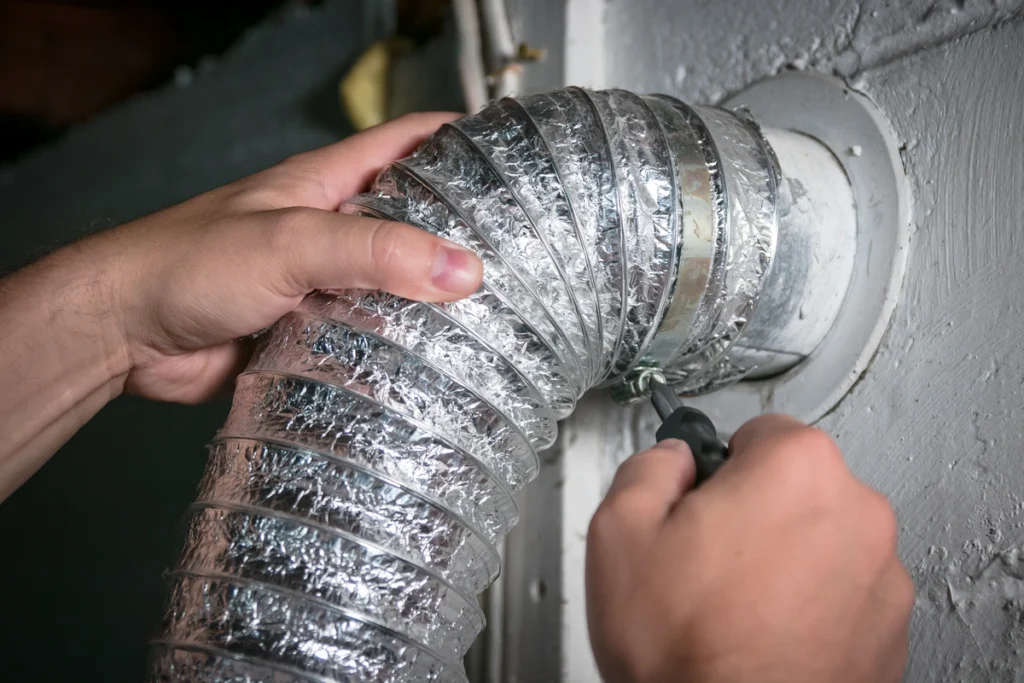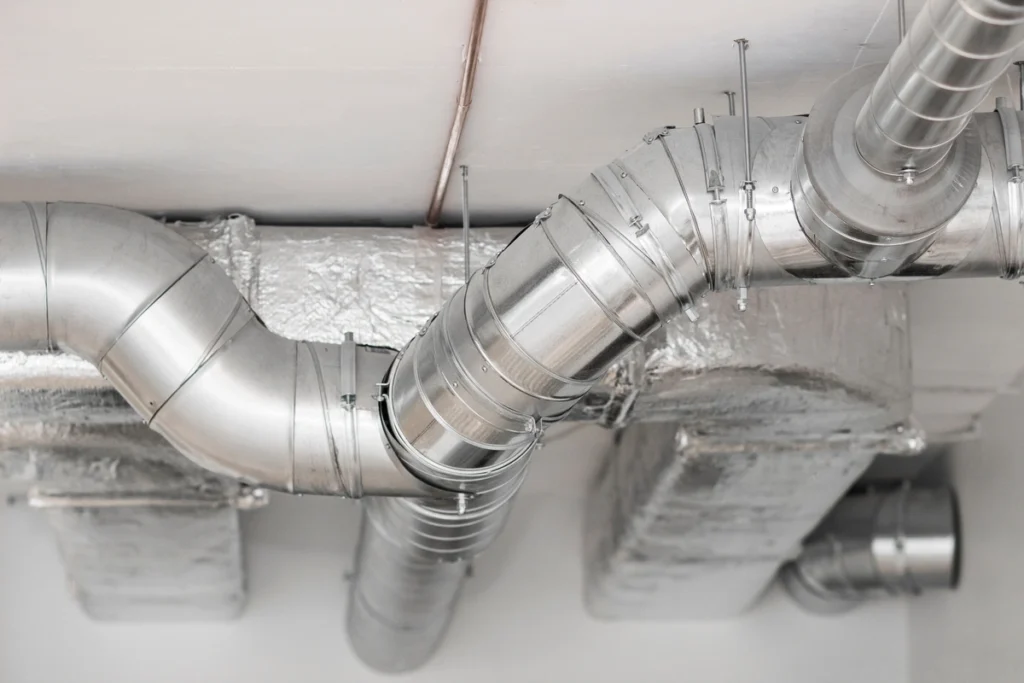Your ductwork plays a crucial role in your HVAC system, responsible for delivering heated or cooled air throughout your home. But when it becomes damaged or deteriorated, it can lead to higher energy bills, uneven temperatures, and poor indoor air quality. Below, we explore when and why you might need duct repair, signs to look out for, and how professional services can help, including:
- Signs that indicate your ducts may need attention
- Reasons for duct replacement or repair
- Problems arising from neglected duct systems
- Types of repairs needed based on location and material
- An overview of associated costs
Common Duct Problems Homeowners Face
Over time, ductwork can suffer wear and tear. Some of the most frequent issues include:
- Leaky Ducts: Cracks or holes that let conditioned air escape.
- Disconnected Joints: Caused by vibration or improper installation.
- Crushed or Collapsed Ducts: Often due to weight from attic storage or pests.
- Mold Growth: Resulting from condensation and poor ventilation.
If you’re experiencing any of these problems, addressing them quickly can prevent long-term damage.
⚠️ Signs You Might Need An Air Duct Repair
Recognizing the early signs that an air duct repair might be necessary can prevent more serious issues and costly repairs down the line. Monitoring the condition of your home’s ductwork and responding to signs of distress promptly ensures that your HVAC system functions efficiently, maintains comfortable and uniform temperatures, protects indoor air quality, and saves on energy costs while reducing the need for major repairs. Regular maintenance checks and timely repairs help safeguard both your well-being and your wallet.
Here are some common indicators:
- Increased Energy Bills: Sudden spikes in your energy bills can often be traced back to inefficiencies in your HVAC system, commonly due to leaking or poorly insulated ducts.
- Inconsistent Airflow and Temperature: Rooms that feel stuffier or have different temperatures from the rest of the house might be suffering from ductwork problems.
- Noisy Operation: Rattling, whistling, or banging sounds can indicate loose ductwork components or blockages.
- Dust and Poor Air Quality: Excessive dust or a decline in indoor air quality can be a sign of leaks in your ductwork, pulling particles from attics, basements, or wall cavities into the air you breathe.
- Visible Damage: Any signs of crushed, disconnected, or visibly damaged ducts are clear indicators that repair or replacement is necessary.
DIY vs. Professional Duct Repair
DIY fixes like applying foil tape to seal visible cracks can provide temporary relief. However, these are often just band aids. Professional repairs go deeper:
| Task | DIY Approach | Professional Advantage |
|---|---|---|
| Leak Sealing | Foil tape / mastic | Full pressure testing and proper sealing |
| Inspections | Visual check | Camera scopes and air-flow diagnostics |
| Mold Remediation | Basic cleaning | Safe, thorough removal with containment |
Tip: If your ducts are over 15 years old, a professional evaluation is highly recommended.
💡 6 Tips for Duct Repairs

Repairing your home’s ductwork is a critical aspect of maintaining efficient heating, cooling, and ventilation systems.Properly functioning ducts ensure that air flows smoothly and consistently throughout your home, improving air quality and reducing energy costs.
Here are some practical tips for effectively repairing ducts:
1. Identify the Problem
Before undertaking any repair, it’s essential to accurately identify what’s wrong with the ductwork. Use a flashlight to inspect the ducts for any signs of damage such as holes, cracks, or disconnected joints. Listen for unusual noises that could indicate loose parts. If certain rooms in your home are too hot or cold, this could also suggest duct issues. Thermal cameras or smoke pencils can help detect air leaks by showing where cold or hot air escapes.
2. Seal Leaks
An air duct leak is one of the most common duct issues. Sealing these leaks can significantly improve the efficiency of your HVAC system. Use mastic sealant or aluminum foil tape (not duct tape, as it doesn’t hold up well under temperature changes) to seal any leaks. Apply the sealant generously over and around the leak, ensuring that the area is clean and dry beforehand for optimal adherence.
Did You Know?
According to the U.S. Department of Energy, up to 30% of heated or cooled air is lost through leaky ducts in the average home. Sealing your ducts could significantly lower your energy bills and improve air quality.
3. Insulate Ducts
Proper insulation is key to maintaining the temperature of the air flowing through your ducts, especially in unconditioned spaces such as attics, crawl spaces, and basements. Check existing insulation for any damage or deterioration. Replace it or add additional insulation where necessary, using insulation materials appropriate for ductwork, such as fiberglass or foil-backed foam.
4. Repair Damaged Ducts
If your ducts are damaged, ductwork repair like small holes or tears can be patched with duct sealant or metal-backed tape. However, larger areas of damage might require replacing sections of the duct. This can be a more complex task, especially if the ducts are not easily accessible. In such cases, it might be wise to hire a professional to ensure the job is done correctly and safely.
5. Ensure Proper Support
Ducts need to be properly supported throughout their length to prevent sagging and bending, which can lead to constrictions in airflow and increased wear and tear. Check that all supports are intact and spaced appropriately (typically every 4 to 5 feet). Replace or add hangers if necessary to provide additional support.
6. Regular Maintenance
Regularly check and maintain your ductwork to prevent future problems. This includes replacing air filters regularly, ensuring that vents are not blocked by furniture or rugs, and having the entire system inspected by a professional every few years. These simple steps can help extend the life of your ducts and improve the overall air quality in your home.
🧐 Why Air Ducts Need to Be Replaced or Repaired
Air ducts are a vital component of any home’s HVAC system, responsible for distributing conditioned air throughout the living spaces efficiently and comfortably. However, over time, these ducts can suffer from wear and tear, damage, or deterioration due to various factors such as age, environmental conditions, or even improper duct installation. Recognizing when ducts need to be repaired or replaced is essential to maintain optimal functioning of your HVAC system, ensuring it provides reliable comfort while keeping operational costs low.
Air ducts may require repairs or full replacement for several of the following reasons:
- Age and Wear: Over time, ductwork can naturally degrade or become damaged, which impairs its functionality.
- Improper Installation: Ducts that were not properly installed can lead to complications, such as leaks and inefficiencies, requiring corrective repairs or replacement.
- Material Deterioration: Materials like fiberboard, flexible ducting, or even metal can deteriorate or become damaged due to environmental factors or physical wear.
- Energy Efficiency: Upgrading to more energy-efficient ductwork can significantly reduce energy bills and improve the overall comfort of your home.
Duct Repair vs. Replacement: Which is Better?
- Repair is ideal for minor leaks, small sections of damage, or isolated problems.
- Replacement is better when your ducts are:
- Made of outdated materials (e.g., asbestos or fiberglass).
- Undersized or inefficient.
- More than 20 years old and costing you money in energy loss.
We can help you determine the most cost-effective route based on your unique setup.
‼️ Potential Problems from Unmaintained Air Ducts
Neglecting maintenance of air ducts in your home can lead to a host of problems that impact both the efficiency of your HVAC system and the overall health of your living environment. Over time, ductwork can accumulate dust, debris, and even mold, which not only impairs air quality but also forces your heating and cooling systems to work harder, increasing energy consumption and costs.
Neglecting duct maintenance can lead to several problems:
- Health Issues: Poor air quality can exacerbate or lead to respiratory problems, allergies, and other health issues.
- Increased Operating Costs: Compromised ductwork can cause your HVAC system to work harder, leading to higher operating costs and reduced lifespan of the system.
- Comfort Issues: Leaky or damaged ducts can result in poor airflow and uneven heating or cooling, making some areas of your home less comfortable than others.
🛠️ Types of Duct Repairs
The types of repairs that air ducts may require can vary widely depending on the nature of the problem, the material of the ductwork, and the configuration of the HVAC system.
Understanding the specific needs of your duct system—whether it involves applying mastic sealant to seal small leaks, re-insulating to preserve energy efficiency, or addressing larger structural issues—can help ensure that your HVAC system operates efficiently, maintains air quality, and controls home comfort levels effectively.
Duct repairs can vary significantly depending on the ductwork’s material and location:
- Sealing Leaks: For both flexible and rigid ducts, sealing leaks with mastic sealant or metal tape can often resolve air loss issues.
- Insulation Upgrades: Adding or replacing insulation, particularly in unconditioned spaces like attics or basements, can help maintain temperature control and efficiency.
- Reconnecting Sections: Ducts that have become disconnected can be reattached and sealed to restore proper airflow.
- Replacing Sections: Severely damaged sections of ductwork, particularly in accessible areas like basements, may need to be completely replaced to ensure efficient operation.
💵 Range of Costs for Repairs and Replacements

The costs associated with duct repairs and replacements can vary significantly based on a multitude of factors, making it a topic of considerable importance for homeowners. Understanding these variables can help homeowners better anticipate the expenses involved and make informed decisions about how to address issues with their HVAC ductwork effectively.
Here’s a rough guide:
- Minor Repairs: Small repairs like sealing leaks or patching holes might cost between $150 and $400.
- Major Repairs and Replacements: For extensive repairs or replacing sections of ductwork, costs can range from $500 to several thousand dollars, depending on the system’s size and accessibility.
- Whole System Replacement: Replacing all the ductwork in a home can cost anywhere from $2,000 to $7,000 or more, particularly if the ducts are in hard-to-reach locations or require custom sizing.
What Happens During a Duct Repair Visit?
At Palmetto, here’s how we handle it:
- Full System Inspection using air-pressure testing and thermal imaging.
- Leak Detection and sealing with UL-rated materials.
- Airflow Balancing to ensure even comfort in every room.
- Final Efficiency Test to confirm energy savings.
We Can Help With Duct Repairs!
Keeping an eye on your home’s ductwork and addressing issues promptly can save you money and maintain your comfort. Regular inspections, coupled with an understanding of the signs of duct problems and the types of repairs required, can help you manage your home’s air system effectively and efficiently. Call us to learn more about how Palmetto Air Conditioning improves the comfort of your home.
